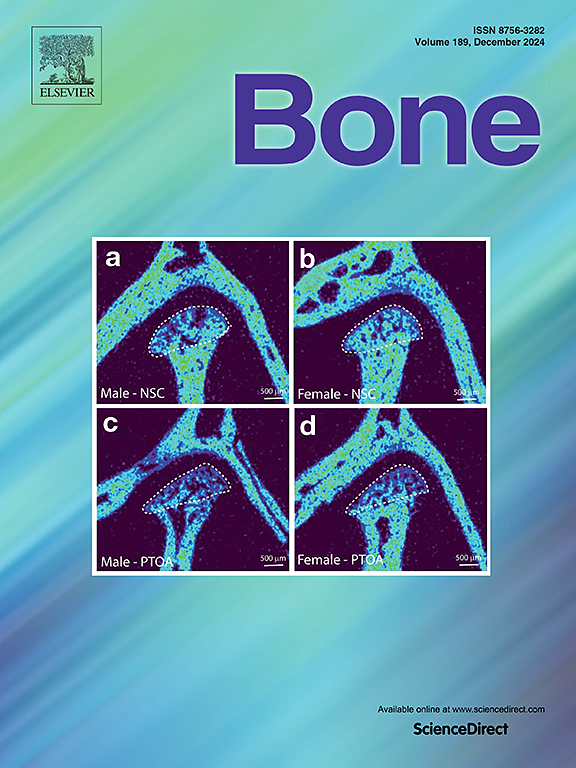Smpd3通过sh - gli1通路调控成牙细胞分化。
IF 3.6
2区 医学
Q2 ENDOCRINOLOGY & METABOLISM
引用次数: 0
摘要
牙齿和头发、皮肤、汗腺等外胚层器官一样,是复杂的结构。具体来说,牙齿由四个主要组织组成:牙釉质、牙本质、牙骨质和牙髓。其中,牙本质是一个关键成分,由成牙细胞合成,成牙细胞是源自神经嵴外间充质前体的特化细胞。成牙细胞对牙本质形成负有独特的责任,这是牙齿发育和功能的重要过程。然而,调节成牙细胞分化的分子机制仍然知之甚少。在这项研究中,我们首先分析了出生后(PN1)小鼠磨牙的公开单细胞RNA测序数据集,发现Smpd3是成牙细胞分化的潜在基因。然后,我们结合组织学、分子和生物信息学方法研究了Smpd3在成牙细胞分化中的功能作用。通过小干扰RNA (siRNA)敲低Smpd3的表达可显著损害小鼠牙乳头细胞(mDPCs)的成牙细胞分化,这可以通过成牙细胞特异性标记物和矿化的减少来证明。相反,Smpd3的过表达增强了牙源性分化,增加了mDPCs矿化结节的形成。为了阐明潜在的分子机制,进行了大量RNA测序,揭示了Smpd3与Sonic Hedgehog (Shh)信号通路的复杂联系。通过体外实验和牙胚培养验证Smpd3通过sh - gli1通路影响成牙细胞分化的机制。在机制上,我们发现Smpd3以sh依赖的方式上调牙本质标志物(Dspp, Dmp1)。Smpd3过表达增加Shh通路活性,促进体外牙本质形成。这项研究强调了Smpd3在牙齿发育中的关键作用,并为牙本质发生的分子调控提供了新的见解,为在自然修复受损时促进牙本质再生的方法提供了潜在的治疗靶点。本文章由计算机程序翻译,如有差异,请以英文原文为准。
Smpd3 regulates odontoblast differentiation through the Shh-Gli1 pathway
Teeth, like other ectodermal organs such as hair, skin, and sweat glands, are complex structures. Specifically, teeth are composed of four principal tissues: enamel, dentin, cementum, and pulp. Among these, dentin is a critical component, synthesized by odontoblasts—specialized cells derived from ectomesenchymal precursors originating in the neural crest. Odontoblasts are uniquely responsible for dentinogenesis, a process essential for tooth development and function. However, the molecular mechanisms regulating odontoblast differentiation remain poorly understood.
In this study, we first analyzed a public single-cell RNA sequencing data set of postnatal (PN1) mouse molars and found Smpd3 as a potential gene of odontoblast differentiation. Then, we investigated the functional role of Smpd3 in odontoblast differentiation using a combination of histological, molecular, and bioinformatics approaches. Knockdown of Smpd3 expression via small interfering RNA (siRNA) significantly impaired odontoblast differentiation of mouse dental papilla cells (mDPCs), as evidenced by reductions in odontoblast-specific markers and mineralization. In contrast, overexpression of Smpd3 enhanced odontogenic differentiation and increased mineralized nodule formation of mDPCs. To elucidate the underlying molecular mechanisms, bulk RNA sequencing was conducted, revealing that Smpd3 is intricately linked to the Sonic Hedgehog (Shh) signaling pathway. In vitro studies and tooth germ culture were applied to validate the mechanism of Smpd3 on odontoblast differentiation through the Shh-Gli1 pathway.
Mechanistically, we show that Smpd3 upregulates dentinogenic markers (Dspp, Dmp1) in a Shh-dependent manner. Smpd3 overexpression increased Shh pathway activity and promoted dentin formation ex vivo. This study highlights the critical role of Smpd3 in tooth development and provides novel insights into the molecular regulation of dentinogenesis, offering potential therapeutic targets for methods that promote dentin regeneration when natural repairs are compromised.
求助全文
通过发布文献求助,成功后即可免费获取论文全文。
去求助
来源期刊

Bone
医学-内分泌学与代谢
CiteScore
8.90
自引率
4.90%
发文量
264
审稿时长
30 days
期刊介绍:
BONE is an interdisciplinary forum for the rapid publication of original articles and reviews on basic, translational, and clinical aspects of bone and mineral metabolism. The Journal also encourages submissions related to interactions of bone with other organ systems, including cartilage, endocrine, muscle, fat, neural, vascular, gastrointestinal, hematopoietic, and immune systems. Particular attention is placed on the application of experimental studies to clinical practice.
 求助内容:
求助内容: 应助结果提醒方式:
应助结果提醒方式:


